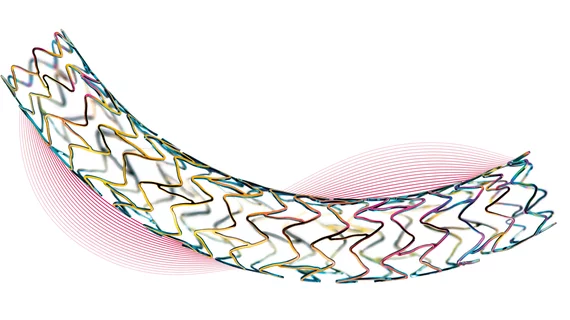TCT.18: Ultra-thin Orsiro stent outperforms Xience at 2 years of follow-up
SAN DIEGO — The ultra-thin Orsiro drug-eluting stent (DES) maintained superior outcomes at two years of follow-up in a head-to-head trial against Abbott’s Xience stent, according to results presented this weekend at Transcatheter Cardiovascular Therapeutics 2018 and published online in the Journal of the American College of Cardiology.
The BIOFLOW-V trial randomized 1,344 patients undergoing percutaneous coronary intervention in a 2:1 ratio to either the Orsiro stent or Xience. Baseline angiographic and clinical characteristics were similar between the two groups, the authors reported.
A total of 7.5 percent of patients in the Orsiro group met the primary endpoint of target lesion failure (TLF) at two years, compared to 11.9 percent in the Xience group. TLF was defined as a composite of cardiac death, target vessel-related MI or target lesion revascularization.
While mortality outcomes were almost equal between groups, Orsiro was associated with significant advantages in terms of target vessel MI (5.3 versus 9.5 percent), target lesion revascularization (2.6 versus 4.9 percent) and late stent thrombosis (0.1 versus 1 percent).
“Historically, the Xience stent has been associated with the most favorable safety and efficacy outcomes in interventional cardiology,” said David Kandzari, MD, the director of interventional cardiology and chief scientific officer at Piedmont Heart Institute in Atlanta, and the U.S. principal investigator of the BIOFLOW-V trial. “Now, with superiority demonstrated for the Orsiro stent, it really raises the question of whether there’s a new standard for comparison in drug-eluting stents.”
In an interview with Cardiovascular Business, Kandzari said the trail wasn’t designed to separate which features of the stents contributed to differences in outcomes. Nevertheless, he hypothesized the thinner struts and the bioresorbable polymer of Biotronik’s device may have played a role.
The Orsiro is a bioresorbable polymer sirolimus-eluting stent with a strut thickness of 60 microns, while the Xience is a durable polymer everolimus-eluting stent with struts of 81 μm.
“There’s certainly a wealth of information and a growing body of information supporting this ultra-thin strut hypothesis, that thinner struts are associated with less injury to the vessel wall, less turbulent flow within the artery, perhaps less inflammation and improved healing as well,” Kandzari said. “So, certainly the ultra-thin strut component gets a lot of attention and there are data in previous studies that would also suggest that ultra-thin strut stents are associated with lower rates of myocardial infarction, both periprocedural and late thrombotic events—like late stent thrombosis as well—and those are exactly some of the differences that we see in the BIOFLOW-V trial.”
The key differences from one-year of follow-up to two years, Kandzari said, included the widening gaps for target lesion revascularization and late stent thrombosis. The investigator noted Orsiro’s polymer fully degrades within the first 12 to 24 months following implantation.
“Whereas the differences we saw at one year could probably not be attributed to the bioresorbable polymer, now at two years it could be related to both the thin strut and the bioresorbable polymer,” he said.
Orsiro is the thinnest-strut DES on the market in more than 100 countries but hasn’t received commercial approval in the U.S. The BIOFLOW-V study, which is funded by Biotronik, has planned follow-up out to five years.

